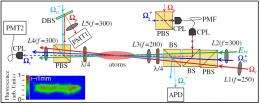May 8, 2012 feature
Two stopped light pulses interact with each other

(Phys.org) -- For the first time, physicists have experimentally demonstrated the interaction of two motionless light pulses. Because the stopped light pulses have a long interaction time, it increases the efficiency with which one photon can switch the path of a second photon. This ability, called photon switching, could have applications in quantum information technologies and photonic circuits, which use light rather than electric currents to manipulate information. Here, the scientists demonstrated an optical switching efficiency that is even higher than the expected limit, and they predict the efficiency can be increased further.
The physicists, from the National Tsing Hua University in Hsinchu, Taiwan, have published a paper on the interaction of two stopped light pulses in a recent issue of Physical Review Letters.
“We have experimentally demonstrated the efficiency of a nonlinear optical process with motionless light pulses that can exceed the previously expected limit,” Ite Yu from National Tsing Hua University told Phys.org. “We also show that the great potential of motionless light pulses is that the efficiency is not limited to the present result but can be further improved by increasing the optical density of the medium.”
As the scientists explain, the efficiency of a nonlinear optical process, such as all-optical switching, is equal to the product of the transition rate (i.e., switching events per second) and the interaction time of the photons. Since the interaction time is usually low due to photons' high speed, scientists generally focus on increasing the light intensity by using more photons, which increases the transition rate. However, by maximizing the interaction time, the scientists here have shown that it's possible to achieve high efficiency even at the single-photon level.
Previously, the possibility of improving optical switching efficiency by increasing the interaction time was thought to be limited. Earlier calculations showed that, when one light pulse is slowed down while the other remains propagating at the speed of c, a mismatch between the two pulse speeds actually shortens the interaction time, and so does not improve efficiency.
In the current study, the scientists overcame this limitation by stopping both the probe pulse and the switching pulse. As a result, the light pulses interacted for a long 6.9 microseconds, leading to an efficiency per unit photon of 1.8.
“There is an approximately four-fold improvement in efficiency as compared with the previously expected limit and about two-fold improvement as compared with the scheme in which only one light pulse is stopped,” Yu said.
The scientists predict that, in principle, when the interaction time is extended to as long as possible, there is no upper limit on the efficiency. They also show that the efficiency can be further improved by increasing the optical density of the medium, which decreases the light level. The improvements could open up a new regime of low-light physics.
“One of the immediate applications of the current work is the single-photon cross-phase modulation (XPM), a challenging task and a typical example in quantum information/computation textbooks,” Yu said. “If large Kerr nonlinearity is attainable in the XPM, one can employ the scheme in quantum nondemolition measurements. If a phase shift of the order of pi can be achieved in the single-photon XPM, one can build the controlled phase gate, which is the basic and essential element in quantum computation.”
More information: Yi-Hsin Chen, et al. “Demonstration of the Interaction between Two Stopped Light Pulses.” PRL 108, 173603 (2012). DOI: 10.1103/PhysRevLett.108.173603
Copyright 2012 Phys.Org
All rights reserved. This material may not be published, broadcast, rewritten or redistributed in whole or part without the express written permission of PhysOrg.com.

















